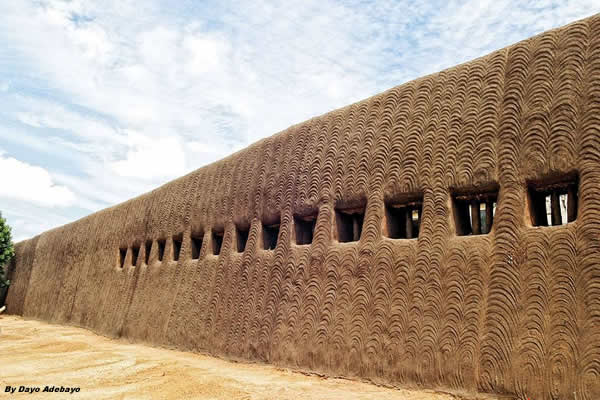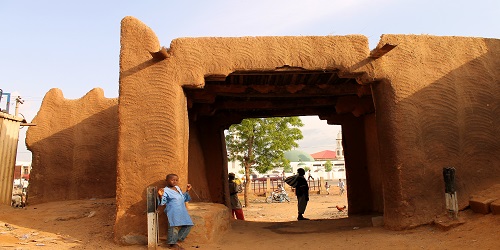
Ancient Kano City Wall is a 14km radius earth structure, while associated sites are made up of these features, Dala Hills, Kurmi Market and Emir's Palace.The ancient Kano city walls were built in order to provide security to the growing population. The foundation for the construction of the wall was laid by Sakri Gijimasu from 1095 - 1134 and was completed in the middle of 14th Century during the reign of Zamnagawa. In the 16th century, the walls were further extended to their present position. The gates are as old as the walls and were used to control movement of people in and out of the city. Though, most of them are largely in ruins.
Though, most of them are largely in ruins. Ancient Kano City walls and associated sites are places of spiritual, historical and cultural significance. Dala Hill was the place of the first settlement in Kano City and it formed the nucleus for the peopling of the rest of the city and was the foundation of its economic and political development.The site bears testimony to local craftsmanship and ingenuity as is evidenced in the materials used for the construction of the walls and palace. The ancient Kano city walls and associated sites are a cultural landscape that the people still pride themselves in.The site can compare with other sites like Zaria city wall, Kufena archaeological site and Daura City wall all in the northern part of the country. Kano, right from its beginning, is commercial town. This has helped in the rapid development of the city. It sprawls over a wide expanse of savannah land.
Although the city has long taken a modern cosmopolitan hue, relics of the city’s past as the hub for commercial activities during the trans-Saharan trade still remain. The real identity of Kano can best be felt in old city area. The mud houses with distinct Hausa local architectural dexterity, the narrow roads that were meant for only men and their domestic animals are still there. However, this is gradually being lost as the ancient structures go modern.The relics are gradually being wiped away by both man and nature. The walls also helped in monitoring the movement of people in and out of the city.
In 1903 when the British forces captured the ancient city, Sir Frederick Lugard, then High Commissioner of the British Protectorate of Northern Nigeria, said: “The extent and formidable nature of the fortifications surpassed the best informed anticipations of our officers, needless to say that I have never seen or even imagined anything like it in Africa.”The walls are among the major tourist attractions in the city; that probably explains why the state government in conjunction with the National Commission for Museums and Monuments (NCMM) is working towards making the walls World Heritage Site. But while the government agencies are working, some individuals including indigenes don’t seem to appreciate the importance of the gates as most of the ancient walls have crumbled.

At the rate of their current degradation, there may not be any wall standing soon. Another heirloom of Kano is on the brink of extinction – the Kano gates. At its current rate of degradation, in the next 10 years, the Kano traditional gates may all be lost.Recently, one of the gates was reportedly being demolished by a road construction company to pave the way for the road expansion and reconstruction which are still ongoing in the state. The gates, by history, were built during the reign of Sarkin Kano Usman Giji Masu Dan Wasiri, the grandson of Bagauda, the third king in the Habe dynasty. He started the first gate in 1112AD.
The reason for the gate was due to the construction of protective walls to surround the ancient city against invaders. Below are facts about the gates, which in the beginning, were originally 16. Kofar Kansakali: It is the first gate which was built in 1112 AD. Its foundation was laid by Sarki Giji Masu. It was named after the first son of Kano (after whom the city was named) called Damina, popularly known as Kansakali. He was a blacksmith.
The gate is located at Tudun Yola quarters in Ungogo Local Government Area. Kofar Waika: Immediately after the completion of Kofar Kansakali, the King moved forward a little distance for the building of this gate which was named after Waika, Kano’s second son.The gate of Waika is situated off Aminu Kano Way behind Goron Dutse. Kofar Dawanau: This gate was initially named after the third son of Kano called Makeri (who was also known as Dan Kwai). Kofar Ruwa: This is the fourth city gate built by Sarki Usman Dan Warisi. Kofar Mazugal was built two years after the completion of Kofar Lunkwui in 1118 AD by the then Sarki Usman Giji Masu Dan Warisi and located along Gwammaja Road.




